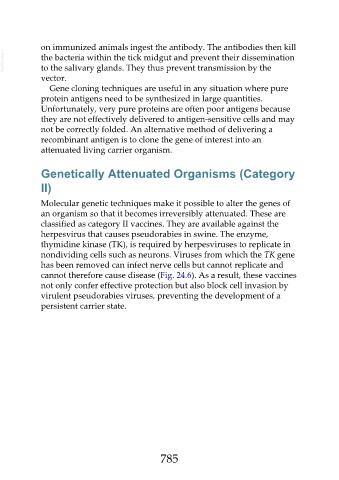Page 785 - Veterinary Immunology, 10th Edition
P. 785
on immunized animals ingest the antibody. The antibodies then kill
VetBooks.ir the bacteria within the tick midgut and prevent their dissemination
to the salivary glands. They thus prevent transmission by the
vector.
Gene cloning techniques are useful in any situation where pure
protein antigens need to be synthesized in large quantities.
Unfortunately, very pure proteins are often poor antigens because
they are not effectively delivered to antigen-sensitive cells and may
not be correctly folded. An alternative method of delivering a
recombinant antigen is to clone the gene of interest into an
attenuated living carrier organism.
Genetically Attenuated Organisms (Category
II)
Molecular genetic techniques make it possible to alter the genes of
an organism so that it becomes irreversibly attenuated. These are
classified as category II vaccines. They are available against the
herpesvirus that causes pseudorabies in swine. The enzyme,
thymidine kinase (TK), is required by herpesviruses to replicate in
nondividing cells such as neurons. Viruses from which the TK gene
has been removed can infect nerve cells but cannot replicate and
cannot therefore cause disease (Fig. 24.6). As a result, these vaccines
not only confer effective protection but also block cell invasion by
virulent pseudorabies viruses, preventing the development of a
persistent carrier state.
785

